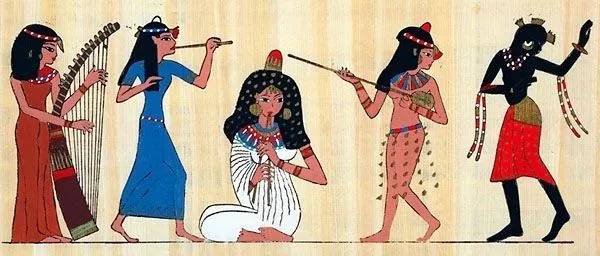Dancing as art in Ancient Egypt
Ancient Egyptians loved music and dance. In fact, many men and women chose music and dance as a career and became professionals. Leisure hours in Egypt were filled with singing and dancing. Dance was performed not just for recreational purposes but on other occasions as well. Farmers danced to thank the gods for a good harvest and dance troupes of males and females were a popular mode of entertainment after dinner for the rich.
A career as a dancer was a respectable one in ancient Egyptian society even when a woman chose it. Dancing in ancient Egypt was an acceptable part of life and even an important part of religious rituals. Most festivals and celebrations in Egypt were incomplete without dancing. All festivals like The Sed-festival, the Opet Festival, Processions of the Sacred Barques, and other festivals, were all accompanied by elaborate dance performances.
Female Dancers In Ancient Egypt
Female dancers in ancient Egypt wore diaphanous robes and belt girdles which were crafted from cowrie shells or beads. The movements of dancers in ancient Egypt have been described by most scholars as graceful, elegant, and even acrobatic.
Seven Types Of Ancient Egyptian Dance:

- The gymnastic dance included more strenuous and difficult movements that required training and flexibility with great physical strength.
- Movement dance was one where there were simple movements in the dance. It was enjoyed by both dancers and the audience.
- Pair dance was a couple of dances either by two men or two women dancing together.
- Imitative dance depicted the emulative movements of animals and appears only in Egyptian texts as an art.
- The group dance was where four or eight people danced together while performing different steps but matching the rhythms.
- The dramatic dance was one where females rested an illustration, especially like a defeated enemy or another such occasion.
- War dance was performed as recreation for the resting mercenary troops from Libya and Sudan.
- Grotesque dance was particularly performed by the dwarves.
- Lyrical dance was one which illustrated a story that was usually performed by a male and a female together.
- The funeral dance was categorized into three which included a ritual dance, a Dance for expressions of grief, and a dance to entertain the Ka of the deceased.
- The religious dance was performed during temple rituals and usually by trained dancers and signers when hymns were the chant.
Much of what is known about ancient Egyptian dance is from the murals, paintings, and etchings on the walls of the temples, tombs, and pyramids. The illustrations show that the dance was usually performed to honor the gods and also at some special times but the exact meaning of the particular movements cannot really be deciphered from the paintings on the walls. Meanwhile, it’s clear to historians and Egyptologists that dance during ancient times was a common and important part of life.





































